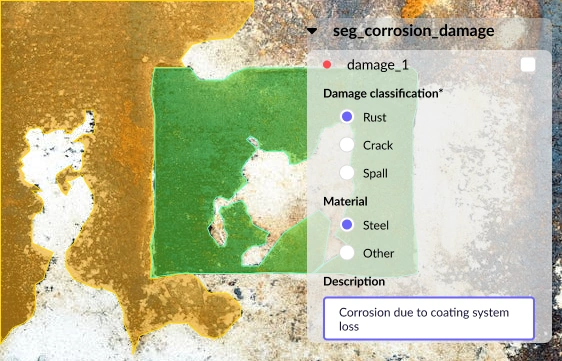Orchestrating in-depth classification for structural complexities in oil and gas
22,500
annotations completed
>90%
accuracy
Faster
and more accurate inspection process
USE CASE
Automated visual inspection | Computer vision for damage assessment
INDUSTRY
Oil & Gas
SOLUTION
Data Stack | Design Stack | Skill Stack

The mission: Improve the rectification rate of structural damages with AI-powered inspection
A global oil and gas conglomerate set out to modernize how it identifies structural damage. It intended to deploy a computer vision model to classify structural elements and detect damage severity within images. This would enhance the speed of data validation by human inspectors, resulting in improved turnaround times in rectification. Expertise and experience were vital in the highly technical field.
The challenge: Aligning industry knowledge and processes across multiple parties
Achieving quality data for the AI model requires specialized knowledge from experienced industry professionals. Without an internal data labeling team, external expertise had to be brought in to speed up the process.
Key obstacles
- Structural damage is subjective, nuanced, and varies from image to image
- Precision in annotations is crucial to meet engineering-grade standards to effectively support model training for critical infrastructure inspections
- Finding annotators with the technical knowledge to accurately identify and label structural damage types, severity, and components proved difficult in a niche field
- Inconsistent outputs from a previous vendor, falling short of the 90% accuracy benchmark, resulting in added mandays to identify, compile, and correct errors
- Effective collaboration between the client's inspection experts and the annotation team was essential to define data labeling protocols and edge cases
The goal
Enable accurate, audit-ready structural damage labeling and compliant workflows.
The solution: Expert-led labeling with built-in collaboration loops
To ensure the data quality of a specialized industry, we designed a system founded on co-creation where we bring together people and processes.
Our approach
- Worked with the client's civil engineering team to design a data labeling workflow through proofs of concept and thoroughly tested it to ensure scalability and label accuracy
- Recruited external annotators with proven experience in engineering projects to work on the classification tasks, with an agreed-upon format
- Trained all annotators on the client's desired format and labeling taxonomy to meet compliance expectations and reduce onboarding friction
- Initiated a weekly feedback loop led by Project Managers in collaboration with the client to resolve edge cases proactively and align on evolving standards to continuously expand the annotation team's expertise for higher accuracy and consistency

The results: Classification model performance at its peak
- Completed 22,500 classification tasks within the required time
- Achieved over 90% accuracy, meeting the client's expectations
- Enabled a faster and more accurate inspection process for the client's dedicated team
Inspection teams were empowered with AI-enabled insights that elevated operational readiness, ensured compliance with safety standards, thereby laying the foundation for smarter infrastructure maintenance at scale.
Break through complex data
Unlock high-performing AI models in niche use cases with collaborative workflows.
More stories

Solving cross-border talent gap for medical annotation across SEA
Mobilized qualified medical professionals across multiple countries in Southeast Asia to power an AI model for thyroid diagnostics, bridging the gap between clinical expertise and machine learning needs.

Turning mission-critical data into waste intelligence
Accelerated waste recognition AI by delivering 1 million high-accuracy, compliance-ready annotations monthly through expert-driven workflows and rapid data turnaround.

Solving language blind spots with culturally fluent AI
Engaged multilingual Asian talents to capture local language and cultural nuance, accelerating high-accuracy training for an AI communication model.